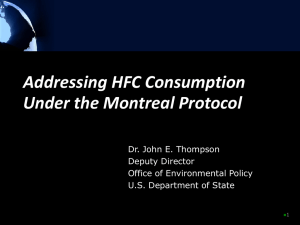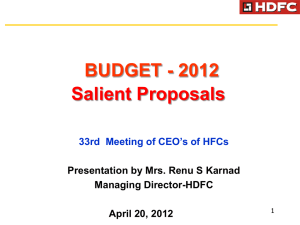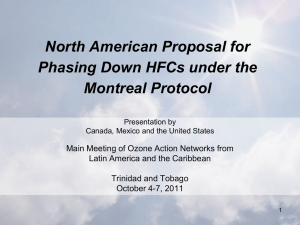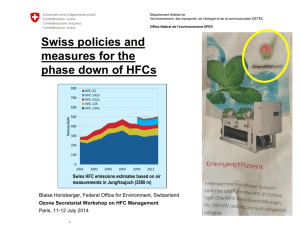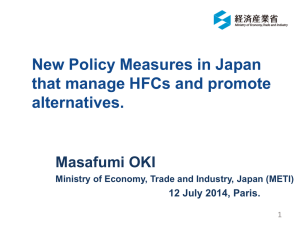The role of HFCs for ozone layer and climate protection
advertisement
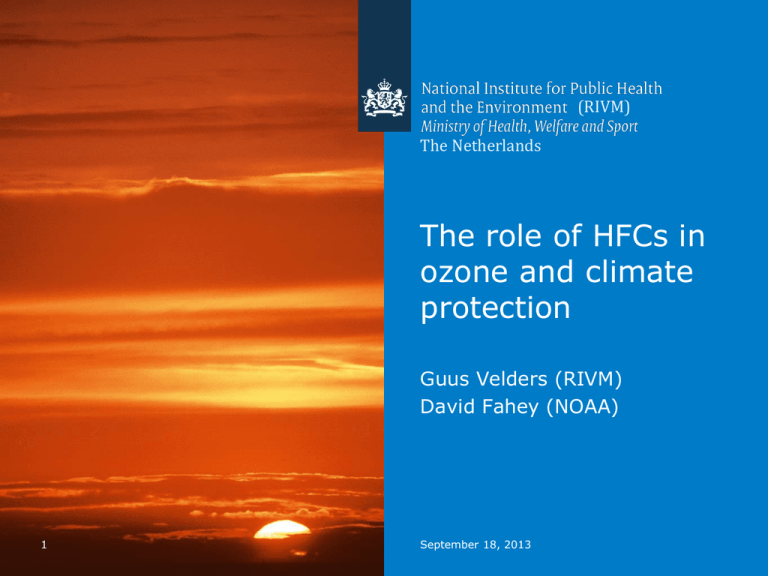
(RIVM) The Netherlands The role of HFCs in ozone and climate protection Guus Velders (RIVM) David Fahey (NOAA) 1 September 18, 2013 Montreal Protocol changed chemicals used ● Montreal Protocol on Ozone Depleting Substances ● It caused a change in chemicals used for refrigeration, AC, foam blowing, cleaning, fire extinguishing, etc.: CFCs HCFCs + other techn. HFCs + other techn. ● Well known benefits for ozone layer ● CFCs, HCFCs, HFCs are all strong greenhouse gases ● GWPs: – CFCs: – HCFCs: – HFCs: 2 4,700 – 11,000 100 – 2,200 130 – 4,200 Guus Velders Large climate benefits Montreal Protocol CO2 emissions World avoided by the Montreal Protocol Reduction Montreal Protocol of ~11 GtCO2-eq/yr 5-6 times Kyoto target (incl. offsets: HFCs, ozone depl.) Velders et al., PNAS, 2007 3 Guus Velders Expected large growth in HFC use ● CFCs: Global phaseout since 2010 ● HCFCs: – Developed countries: controls since 1996 – Developing countries: controls start in 2013 – Virtually complete phaseout in 2020/2030 Much of application demand for refrigeration, air conditioning, heating and thermal-insulating foam production to be met by HFCs Montzka, NOAA/ESRL – Current forcing small (<1% of total GHG forcing) – Current growth rates of HFCs: 10-15% per year ● Increases directly attributable to Montreal Protocol ● Climate effect is a unintended negative side effect Photo W.S. Velders 4 Guus Velders HFCs offset climate benefits Montreal Protocol • BAU scenario of HFCs: • Based on IPCC-SRES • Observed replacements patterns • In 2050, HFC emissions: 5.5–8.8 GtCO2-eq yr-1 = 9–19% of global CO2 emissions • In 2010, CFCs could have reached 15–18 GtCO2-eq yr-1 (in absence of Montreal Protocol) Velders et al., PNAS, 2009 5 Guus Velders Offsets in terms of radiative forcing ● In 2010, reduction due to Montreal Protocol 0.23 W/m2 (incl. offsets) ● In 2050, forcing HFCs 0.25–0.40 W/m2 – Compared with CO2 (BAU) of 2.9–3.5 W/m2 – Equivalent to that from 6–13 years of CO2 emis. 6 Guus Velders What is happening in the political arena ● HFCs not controlled by Montreal Protocol, but included in basket of gases of Kyoto Protocol ● Amendments proposed to include HFCs in Montreal Protocol – Support: problem caused by MP; instruments available – Opposition: no ODS; already in Kyoto; financial/legal concerns ● Climate considerations are in the text of the Montreal Protocol ● Very recent (Sept. 2013): G20 supports initiatives to use expertise and institutions of Montreal Protocol to phase down HFCs 7 Argentina, Australia, Brazil, Canada, China, France, Germany, India, Indonesia, Italy, Japan, Korea, Mexico, Russia, Saudi Arabia, South Africa, Turkey, the United Kingdom, the United States, and the European Union, as well as Ethiopia, Spain, Senegal, Brunei, Kazakhstan, and Singapore. What is happening in industry (car makers) ● Since 1990s all mobile air-conditioners use HFC-134a (GWP 1370) ● In EU: mobile air-conditioning directive: – Refrigerant should have GWP <150 – From 2011 for new type of vehicles (derogation until 12/2012) – in 2013: German car maker still use HFC-134a France blocks registration of new Mercedes ● Alternatives for HFC-134a: – HFC-1234yf (more or less drop in replacement) – CO2 promoted by German EPA (needs redesign of engine) 8 Guus Velders Wide range of HFC lifetimes and GWPs ● Fully saturated HFCs: – HFC-32, -125, -134a, -143a, -152a – Lifetimes: 1 to 50 yr – GWPs: 100 to 4000 ● Unsaturated HFCs (HFOs): – HFC-1234yf, -1234ze – Lifetimes: days to weeks – GWPs: ~20 or less ● If current HFC mix (lifetime 15 yr) were replaced by HFCs with lifetimes less 1 month forcing in 2050 less than current HFC forcing Velders et al., Science, 2012 9 Guus Velders Alternatives to ODSs and HFCs ● Replacing high-GWP HFCs with substances with low impact on climate: – Hydrocarbons, CO2, unsaturated HFCs – Alternative technologies ● Reducing emissions: – Changing designs – Capture and destruction ● Low-climate impact alternatives already available commercially in several sectors: – – – – Fiber insulation materials (e.g., mineral wool) Dry powder asthma inhalers Hydrocarbons, CO2, ammonia in refrigeration systems Unsaturated HFCs are being introduced for foams, aerosols and mobile AC ● Also important: LCCP, costs, availability, flammability, toxicity, humidity, etc. 10 Guus Velders Conclusions ● Climate benefits Montreal Protocol can be preserved by limiting HFC growth ● Alternatives already commercially available for several sectors ● Challenge for policymakers: identify how this can be accomplished 11 Guus Velders Thank you for your attention References: - 12 HFC-134a and its main IR-frequency Velders et al., Proc. Natl. Acad. Sci., 104, 2007 Velders et al., Proc. Natl. Acad. Sci., 106, 2009 UNEP: HFC-report, 2011 Velders et al., Science, 335, 922, 2012 Guus Velders Backup slides 13 Guus Velders, Aug. 29, 2012 The G-20 agreement on HFCs reads as follows: We also support complementary initiatives, through multilateral approaches that include using the expertise and the institutions of the Montreal Protocol to phase down the production and consumption of hydrofluorocarbons (HFCs), based on the examination of economically viable and technically feasible alternatives. We will continue to include HFCs within the scope of UNFCCC and its Kyoto Protocol for accounting and reporting of emissions. Second, building on their June 8 accord on HFCs in Sunnylands, President Obama and President Xi agreed at their bilateral meeting as a next step on HFCs to establish a contact group under the Montreal Protocol to consider issues related to cost-effectiveness, financial and technology support, safety, environmental benefits, and an amendment to the Montreal Protocol. The agreement between President Obama and President Xi on HFCs reads as follows: We reaffirm our announcement on June 8, 2013 that the United States and China agreed to work together and with other countries through multilateral approaches that include using the expertise and institutions of the Montreal Protocol to phase down the production and consumption of HFCs, while continuing to include HFCs within the scope of UNFCCC and its Kyoto Protocol provisions for accounting and reporting of emissions. We emphasize the importance of the Montreal Protocol, including as a next step through the establishment of an open-ended contact group to consider all relevant issues, including financial and technology support to Article 5 developing countries, cost effectiveness, safety of substitutes, environmental benefits and an amendment. We reiterate our firm commitment to work together and with other countries to agree on a multilateral solution. 14 Guus Velders, Aug. 29, 2012
